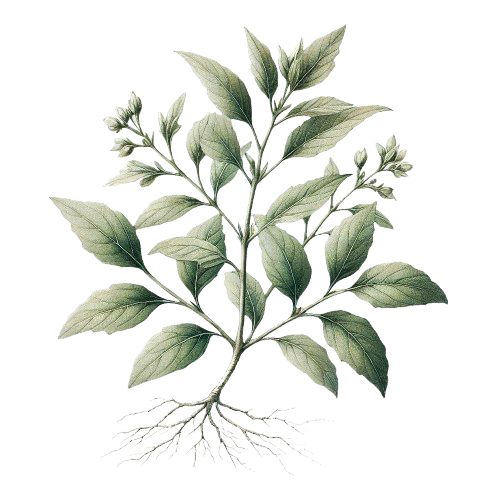
ashwagandha
(withania somnifera)
Botanical Profile and Habitat
Ashwagandha (Withania somnifera), known as Indian ginseng or winter cherry, is a prominent herb in traditional Ayurvedic medicine. It belongs to the Solanaceae family and is characterized by small green flowers and orange-red fruit. The plant thrives in the dry regions of India, northern Africa and the Middle East, adapting well to drought and frost. The root is the most commonly used part for medicinal purposes. Used for over 3,000 years in Ayurveda, ashwagandha’s name translates to "smell of the horse," alluding to its distinct smell and its strength-enhancing properties. Traditionally, it has been utilized to boost energy, reduce stress and promote overall health and longevity.
Health Benefits
Ashwagandha offers a range of health benefits, supported by traditional use and research:
Stress Reduction and Anxiety Relief: As an adaptogen, ashwagandha helps the body cope with stress by lowering cortisol levels. Studies have shown significant reductions in stress and anxiety among users.
Improved Cognitive Function: Research indicates that ashwagandha enhances memory, attention and information processing speed, particularly in those with mild cognitive impairment.
Anti-inflammatory and Antioxidant Properties: Its potent anti-inflammatory and antioxidant properties combat oxidative stress and inflammation, potentially reducing the risk of chronic diseases.
Enhanced Physical Performance: Ashwagandha has been shown to increase muscle strength, mass and endurance, benefiting athletes and fitness enthusiasts.
Support for Mental Health: The herb aids in managing depression by modulating neurotransmitters like serotonin and dopamine, enhancing mental well-being.
Ashwagandha is a cornerstone of Ayurvedic medicine, valued for its ability to improve stress resilience, cognitive function and physical performance. Its anti-inflammatory and antioxidant properties further enhance its therapeutic potential, making it a valuable addition to modern herbal medicine.
ashwagandha
Botanical Profile and Habitat
Ashwagandha (Withania somnifera), known as Indian ginseng or winter cherry, is a prominent herb in traditional Ayurvedic medicine. It belongs to the Solanaceae family and is characterized by small green flowers and orange-red fruit. The plant thrives in the dry regions of India, northern Africa, and the Middle East, adapting well to drought and frost. The root is the most commonly used part for medicinal purposes. Used for over 3,000 years in Ayurveda, ashwagandha’s name translates to "smell of the horse," alluding to its distinct smell and its strength-enhancing properties. Traditionally, it has been utilized to boost energy, reduce stress, and promote overall health and longevity.

Health Benefits
Ashwagandha offers a range of health benefits, supported by traditional use and research:
Stress Reduction and Anxiety Relief: As an adaptogen, ashwagandha helps the body cope with stress by lowering cortisol levels. Studies have shown significant reductions in stress and anxiety among users.
Improved Cognitive Function: Research indicates that ashwagandha enhances memory, attention and information processing speed, particularly in those with mild cognitive impairment.
Anti-inflammatory and Antioxidant Properties: Its potent anti-inflammatory and antioxidant properties combat oxidative stress and inflammation, potentially reducing the risk of chronic diseases.
Enhanced Physical Performance: Ashwagandha has been shown to increase muscle strength, mass, and endurance, benefiting athletes and fitness enthusiasts.
Support for Mental Health: The herb aids in managing depression by modulating neurotransmitters like serotonin and dopamine, enhancing mental well-being.
Ashwagandha is a cornerstone of Ayurvedic medicine, valued for its ability to improve stress resilience, cognitive function, and physical performance. Its anti-inflammatory and antioxidant properties further enhance its therapeutic potential, making it a valuable addition to modern herbal medicine.


